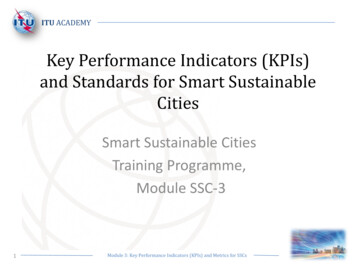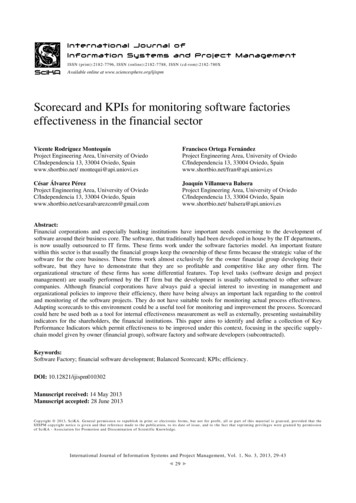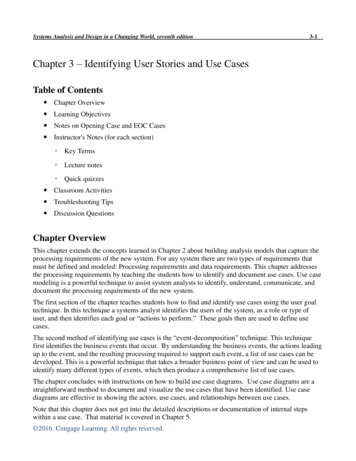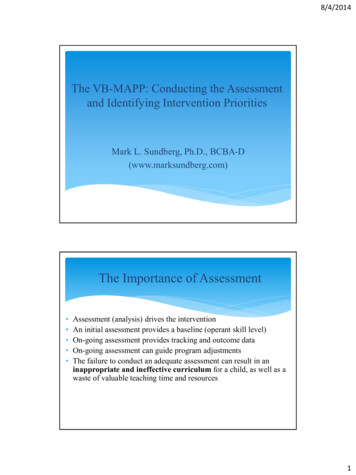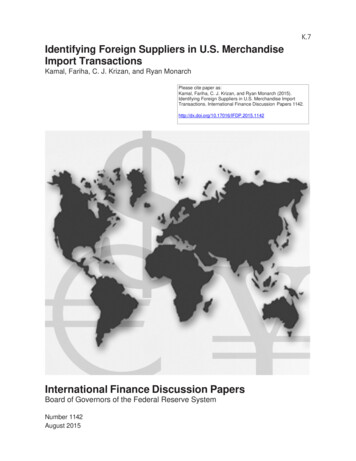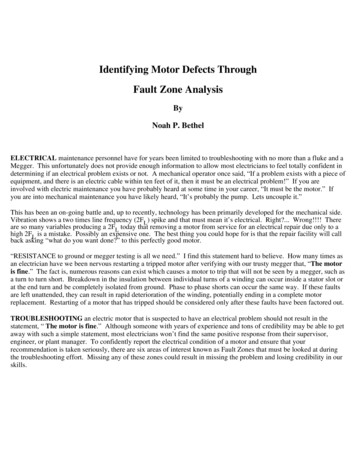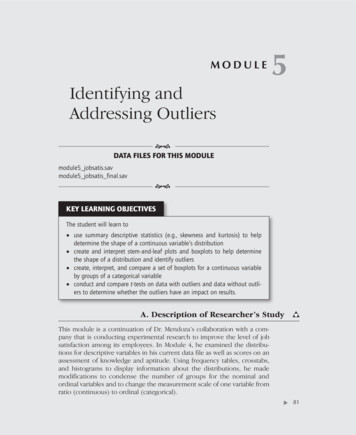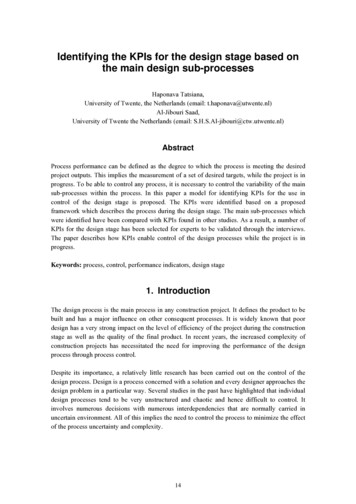
Transcription
Identifying the KPIs for the design stage based onthe main design sub-processesHaponava Tatsiana,University of Twente, the Netherlands (email: t.haponava@utwente.nl)Al-Jibouri Saad,University of Twente the Netherlands (email: S.H.S.Al-jibouri@ctw.utwente.nl)AbstractProcess performance can be defined as the degree to which the process is meeting the desiredproject outputs. This implies the measurement of a set of desired targets, while the project is inprogress. To be able to control any process, it is necessary to control the variability of the mainsub-processes within the process. In this paper a model for identifying KPIs for the use incontrol of the design stage is proposed. The KPIs were identified based on a proposedframework which describes the process during the design stage. The main sub-processes whichwere identified have been compared with KPIs found in other studies. As a result, a number ofKPIs for the design stage has been selected for experts to be validated through the interviews.The paper describes how KPIs enable control of the design processes while the project is inprogress.Keywords: process, control, performance indicators, design stage1. IntroductionThe design process is the main process in any construction project. It defines the product to bebuilt and has a major influence on other consequent processes. It is widely known that poordesign has a very strong impact on the level of efficiency of the project during the constructionstage as well as the quality of the final product. In recent years, the increased complexity ofconstruction projects has necessitated the need for improving the performance of the designprocess through process control.Despite its importance, a relatively little research has been carried out on the control of thedesign process. Design is a process concerned with a solution and every designer approaches thedesign problem in a particular way. Several studies in the past have highlighted that individualdesign processes tend to be very unstructured and chaotic and hence difficult to control. Itinvolves numerous decisions with numerous interdependencies that are normally carried inuncertain environment. All of this implies the need to control the process to minimize the effectof the process uncertainty and complexity.14
The work described in this paper is part of a larger ongoing research project to identify anddevelop performance indicators for the whole construction process. The focus of the researchhas been set on public infrastructure projects because of the considerable risks they face; thelong planning and complexity they involve; the involvement of many public & privatestakeholders with conflicting interests; the big impact they have on public during the projectexecution; and the higher degree of changes they usually encounter compared to other types ofconstruction projects [10].This paper describes investigation related to the early period of the design stage. It covers theframework and methodology proposed for identifying design process-based performanceindicators.The main objective of the work described in this paper is to present the preliminary results of aresearch which aims at defining Key Performance Indicators (KPIs) that are intended to be usedfor controlling the various sub-processes during the design stage. This has been done using aresearch methodology that consists of several steps. First, the design process was mapped toprovide a theoretical framework of the process using literature review. In parallel, existingdesign KPIs were also identified through a literature review and then matched with the maindesign sub-processes that require control. This resulted in a list of selected process-based KPIsfor the design stage to be further validated by experts. The proposed KPIs are aimed not only atcontrolling the process, but also indicating where control action should take place if necessary.2. Main shortcomings of the existing KPIsExisting KPIs are mainly used to benchmark the construction projects against each other and toindicate whether improvement can be made. In recent years indicators have been developed tomeasure different aspects of project performance. A major characteristic of these however is thatmost of them are used primarily for benchmarking purposes but are of little use for controllingthe performance during a project. There are few existing indicators that can be used to informstakeholders of how well their processes are going during the various stages of the project. Forexample, in their work to develop tools on measuring performance, Feurer & Chaharbaghi [11]recommended to keep the focus of measurement on processes rather than on the functions of theproject. Koskela [17] highlighted that process performance is an important feature ofperformance indicators to improve process transparency so that the relevant and invisibleattributes of the process become visible. Pillai [20] also suggested to measure the constructionprocesses rather than their outcomes. This suggestion was supported later by Marosszeky et al.[18], who proposed to identify the critical process targets so that the measurement reflects theproposed project direction and provides feedback in the process.Despite the recommendations made by many authors about the importance for measuringprocess performance, very little work has been done on this front. This is highlighted in thework carried out by Beatham et al. [5] who has made a critical overview of the existing KPIsused in the construction industry. In addition to main shortcomings of existing KPIs highlighted15
by their study, the authors also indicated that almost all indicators in construction are endproduct oriented. They indicated a need for process-based KPIs to control the process while it isstill in progress. This work is an attempt to address the shortcomings of the existingperformance indicators and to identify process-based KPIs that can be used to control thevarious processes in construction. The emphasis of this paper is on the design stage.3. Control of the design stageIn construction each project is unique but most of the project processes are similar [22]. Aprocess can be defined as the transformation of a set of inputs into desired outputs using variousactions, methods and operations. Hence, process performance can be defined as the degree towhich the processes involved in the project execution are meeting the desired project outputswhile the project is in progress. To control a process, it is necessary to control the variability ofthe outputs of its main sub-processes.Table 1. Summary of the literature review on design stage of the construction projectAuthorName of the phasesSR [6]Conceptual designDefinitive designKagiogloual. [15]etBaldwin et al.[4]Outline conceptual designFull conceptual designCoordinated designConcept designScheme designDetailed designAustin[3]Hughes,etal.Detailed design[13]Al-Reshaidal. [1]Detailed designetHandleidingopdrachtgevers,[23]Conceptual designPreliminary designDetaileddesignengineeringTender phaseStructural designCurrent designDefined designandMain sub-processesDevelop spatial and architectonic idea of the project, check and adjustconstructions and installations, conceptual estimation of construction costs,global insight in building of investments’ costsDevelop spatial and architectonic provision of the project, architecturalintegration of constructions and installations, materialization and dimensionsof architectural work, detailed cost estimationprepare cost plan, prepare outline concept designs; prepare work packages,revise project plan, business case, project execution plan, procurement plan,CDM assessment, process execution planprepare full design concept, prepare maintenance planproduce product modelsite planning, preliminary site investigation, drainage concept design,estimating costs, concept design report productionsite investigation, product outline project specifications, revise costestimation, scheme structural design, scheme service design, external worksscheme design, scheme drainage design, scheme architectural designdevelop business need into design strategy, develop design strategy intoconceptual proposalarchitectural design, civil design, structural design, mechanical design,electrical designorganize design team, complete user studies, review cost plan, detail design,engineering detail design, services detail design, cost studies, completeddesign, specification notesformulation; analysis; search; decision; specification; modificationscalculation and analysis; checking and assessment; cost estimate and valueengineering; review and audit; use of information technology; approval.tender scheduling; milestones allocation; schedules monitoring and follow upshape of the product, global assessment of time and costsconsequences for planning and costsdefined shape, place and dimensions of space, construction and installation;use of material; approvalsKoontz & Weihrich [16] indicated that to control the process performance of the design stage itis necessary to establish standards or desired targets, measure performance against set desired16
targets and correct any deviations from desired targets by taking action). Establishing desiredtargets is a process of selecting the degree to which the performance of desired targets should beachieved so that the project managers can establish how the process is going. The actualperformance should then be measured against the set desired targets. The corrective actionshould be taken in case there is evidence of mistakes, recognising lack of progress or identifyingareas of poor quality [19].The design stage is referred to as such in most publications, see, for example, Chan &Kumaraswamy [7]; Baldwin et al. [4]; Austin et al. [3]. Whilst in Kagioglou et al. [15] or AlReshaid et al. [1] it is referred to pre-construction stage. In this paper the design stage is definedbased on the definition of Chan & Kumaraswamy [7] as the stage where the primary concept istranslated into an expression of functional and technical requirements which satisfy the clients’requirements in an optimum and economic way.Table 1 shows a summary of the literature review addressing the main sub-processes of thedesign stage in construction and their main sub-processes. It can be seen from the Table 1 thatdifferent authors include different levels of details to describe the various sub-processes withinthe design stage depending on focus of their work. Table 1 also shows that the design stage isrepresented by two or more phases depending on the scope of the sub-processes it includes. Thescope of the main sub-processes varies from design strategy to the project design parametersand even tender preparations [1].The design process with its sub-processes and main outputs is used in this paper as a basis fordefining the process-based KPIs to control the design process.4. Research methodologyThe main questions concerning this research can be formulated as follows: “What KPIs can beused to control the construction project during the design stage while it is in progress?” and“How can design process be controlled using Key Performance Indicators?”InterviewsLiterature reviewIdentifyingexisting KPIsand theirmainshortcomingsIdentifyingKPIs fordesign stageUnderstandingdesign stageExistingdesign KPIsMain subprocessesMainofoutputssub-Definingprocessbased KPIsfor designstageFirstset ofKPIsValidatingdefinedprocessbasedKPIs forthe designstageFinalsetofKPIsFigure 1. Methodology of the researchThe research objective is to identify process-based KPIs that can be used by the projectmanagers to control the design process. To achieve this objective, a research methodology has17
been adopted that consists of a number of the steps: (1) review of the existing literature on thedesign process and its main sub-processes; (2) review of the existing literature on the existingdesign KPIs; (3) comparison of the main design sub-processes with the existing design KPIs; (4)identification of design process-based KPIs; (5) validation of the proposed set of design KPIsthrough a number of interviews. Figure 1 captures the methodology for identification of theprocess-based KPIs for the design stage.To identify KPIs for control purposes a conceptual model is proposed to establish where thefocus of control would be. The process KPIs are intended to be developed for project managersbecause of their overall responsibility of all of the sub-processes within the whole constructionprocess and the design stage in particular.4.1 Understanding the design stage: a conceptual modelKnowledge and information based resources are the type of knowledge that is possible to bedelivered in written format. It is often called coded knowledge. In practise it may be manuals,drawings, text books, papers, web-pages and other computer systems.A comprehensive literature review was conducted to identify the main phases, sub-processesand their outputs within the design stage. The main sub-processes identified are the focus of thecontrol and the outputs of the identified sub-processes are the issues that should be controlledwithin these sub-processes.As has been shown in Table 1, researchers divided the design stage mainly into three designphases with the same content but different titles of the phases. During the conceptual orpreliminary stage the preliminary design concept is translated into potential design solutions.These potential design solutions are then analysed and the optimal design solution is thenselected in the scheme design phase. The solution is then worked out in details in technical andfunctional terms to satisfy the client requirements during the detailed design phase. Figure 2shows the main sub-processes included within each phase based on the literature review asdescribed in Table 1.C o n c e p t u a l d e s ig n p h a s eS c h e m e d e s ig n p h a s eD e t a ile d d e s ig n p h a s eF u ll d e s ig nconceptD e s ig ns tra te g yD e ta ile d d e s ig nT im e a n d c o s tp la nO u tlin e c o n c e p td e s ig nC o s t s tu d ie s a n dVES itein v e s tig a tio nC o n tr o l P la n sCostassessm entC o n c e p t d e s ig np ro p o s a lS c h e m e d e s ig nFigure 2. Conceptual model based on the literature review18C o m p le te d d e s ig n
A generic conceptual model of the design stage was proposed, in which the main sub-processeswithin the defined phases were mapped as shown in Figure 2.The identification of the main sub-processes and their outputs proposed by this model wasaimed at creating a basis for measuring how the design process is performing and to provide thecontrol information necessary for project managers involved in the process.4.2 Existing design KPIsRegarding the design stage of the construction projects a number of design KPIs was developedto measure the performance of the projects.Amongst the KPIs, proposed by the Construction Best Practice Program (CBPP) in the UK,predictability-cost and predictability-time are those related to the design stage. The indicatorswere developed for different construction sectors and include, for example, new build socialhousing, new build private housing, major infrastructure etc. [9]. However, the proposed KPIswere developed to benchmark the completed projects and are of little use for control of thedesign process.CIRIA (Construction Industry Research and Information Association) developed its own CIRIACDAPT Design KPI Assessment Tool. This tool provides measurement of both processes andoutcomes of the project. The proposed design KPIs are: understanding client’s needs, designprocess, integration of design with supply chain, internal cost/time management, risk, re-use ofdesign experience, innovation and client/user satisfaction. The tool is developed to be used afterthe processes are finished [8].Another tool - the Design Quality Indicator (DQI) – was developed to measure and manage thedesign of the buildings. The tool is based on involving all stakeholders in discussion on bothobjective and subjective design aspects of the on-going projects. The DQI measures threeaspects: functionality, impact and build quality, where each of these aspects has its mainattributes. DQI, however, is not an absolute measure and the focus of measurement is only onthe design of the buildings [14].Hansen and Vanegas [12] made an overview of the existing design KPIs that are also used tomeasure design quality of building projects. They proposed their own brief automation tool,which includes 12 performance parameters identified based on the existing design KPIs.A summary of studied literature on design performance indicators described in differentliterature sources is presented in Table 2.It can be seen from the Table 2 that the majority of the design KPIs are product-oriented, theothers are either too generic (such as design process, risk, innovation) or are developed for19
specific construction sectors such as the building sector. Only few KPIs are related toinfrastructure construction projects.Table 2. Summary of the literature review on the existing design KPIsSourceGann et al.DQI buildingsDesign KPIs[14] ¾ Functionality (use, access, space, character & innovation)¾ Impact (form &materials, internal environment, urban & social integration)¾ Build quality (construction, engineering systems, performance)¾ Contextual compatibility &¾ Safety / securityresponse¾ Risk¾ Functional performance¾ Constructability¾ Physical performance¾ Maintainability¾ Cost¾ Health and¾ Time¾ Sustainability¾ Quality / reliability¾Scope¾ Commercial validationAnderson, D.K. &¾ Concurrency¾ PracticalityMerna, T. [2]¾ Specifications¾ Quality¾ Technical validation¾ Innovation¾DesignprocessCIRIA [8]¾ Integration of design with supply chain¾ Internal time/cost management¾ Risk¾ Reuse of design experience¾ Innovation¾ Client/user satisfaction¾Predictability-costDETR [9]¾ Predictability-time¾ Waste (product was designed for minimum waste materials)¾ Energy use (designed)¾ Main water use (designed)¾ Impact on biodiversityUgwu and Haupt [21] ¾ Environmental impacts¾ Innovative solutions that optimize the use of resources including design forinfrastructuredurability, constructability and deconstruction¾ Material reuse¾ Recycle and waste management¾ Impact of design decisions on the wider ecosystem¾ Innovative construction methods and technologyHansen & Vanegas,[12] buildingsTo answer the research question: “What KPIs can be used to control the construction processduring the design stage while the project is in progress”, the design KPIs identified through theliterature review have been split into product-oriented and process-oriented measures. It wasconcluded that there is a strong misbalance between the two groups of the indicators. The maingroup of process-oriented indicators were developed by CIRIA [8]. These included designprocess, integration of design with supply chain, and risks. The process-oriented KPIs derivedfrom the literature study were compared with the KPIs identified based on the main design subprocesses of the conceptual model to compose the final list the proposed process-based KPIs tobe used.20
4.3 Defining process-based KPIs for the design stageThe following step of the research is to verify the list of the identified process-based KPIs forthe design stage by experts through interviews. The experts have already been selected based ontheir experience of working as project managers in the design stage of the infrastructureprojects.The interviews will be conducted based on the prepared questions. The purpose of theinterviews will be to:1) validate the process-based KPIs chosen based on the results described in the previoussections and2) identify the focus of control within the proposed KPIs.The questions for the interviews, designed to facilitate data collection, are split into two mainsections. The first section involves the questions related to information about the experts’bac
research which aims at defining Key Performance Indicators (KPIs) that are intended to be used for controlling the various sub-processes during the design stage. This has been done using a research methodology that consists of several steps. First, the design process was mapped toFile Size: 690KB

